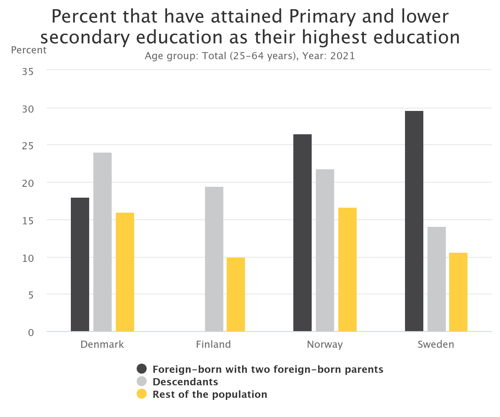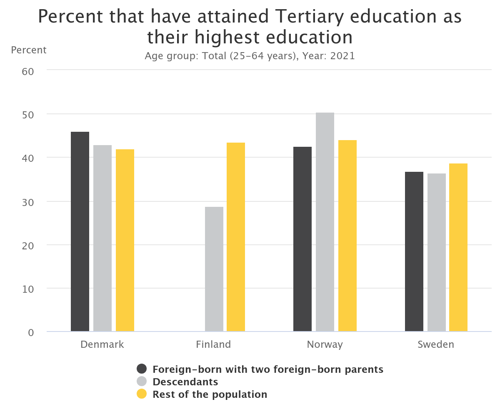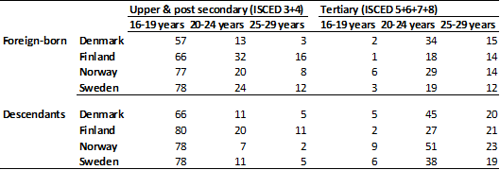Integration, migration and education
Novel data on integration and migration in the Nordic Statistics database is the base for this third article on the topic, this time with focus on educational attainment and enrolment. Here we learn that there are no large, systematic differences between the educational levels of immigrants, their descendants and the rest of the population in the Nordic countries and that descendants of immigrants participate in education more frequently than immigrants.
In the summer of 2024, 12 matrices on immigration and migration were updated in the Nordic Statistics database. Data can be found here. On November 1st, the first article in a series on the topic was published, focusing on demographics. On November 29th, a second article, with a labour market perspective, was published. Now, we conclude by focusing on education.
Education is one of the most important integration factors for immigrants and their descendants. Analyses from Statistics Norway show that the level of education has a great impact on both economic opportunities and social mobility among immigrants [1].
Data collected on education, within the framework of integration and migration, covers level of education achieved, enrolments by level of education and the number who have not completed secondary education. It is possible to compare population categories (Foreign-born, Descendants and the Rest of the population [2]), sex and in some cases age.
Highest level of education attained
There are no large, systematic differences between the educational levels of immigrants, their descendants and the rest of the population in the Nordic countries. Immigrants generally have higher proportions with only primary or lower secondary education (ISCED 1 and 2, Figure 1), but lower proportions with upper and post-secondary education (ISCED 3 and 4, Figure 2), and a fairly similar proportion with tertiary education (ISCED 5-8, Figure 3) as the highest level of education completed, compared to the rest of the population. Please note that no data on the population category Rest of population is available for Finland.
Descendants are often young, which explains a relatively high share with only primary and lower secondary education compared to the rest of the population. The share with upper and post-secondary education among descendants is higher than among immigrants, but largely lower than among the rest of the population. The share of descendants with upper and post-secondary education is highest in Finland with 52 percent, which is higher than in the rest of the population. In Denmark and Norway, we find higher shares with university and college (i.e. tertiary) education among descendants than among the rest of the population.

Figure 1. Source: Nordic Statistics database, EDUC32

Figure 2. Source: Nordic Statistics database, EDUC32

Figure 3. Source: Nordic Statistics database, EDUC32
Enrolment
The enrolment rate for upper and post-secondary education is generally highest for the 16-19 age group, while participation in tertiary education is highest for the 20-24 age group.
The proportion of immigrants aged 16-19 participating in upper and post-secondary education was lowest in Denmark (57 percent) and highest in Sweden (78 percent). Among descendants in the same age group, the proportions were the same as those of foreign-born in Norway and Sweden and higher in Denmark and Finland.
Finland stands out with higher participation rates in upper and post-secondary education, especially among descendants. In all three age groups, the proportion of descendants participating in upper and post-secondary education in Finland was s higher than in the other Nordic countries.
Enrolment rates for tertiary education (i.e. university and college) were highest in the age group 20-24 years, both for foreign-born and descendants. For the foreign-born population, the four countries were divided into two groups – Finland and Sweden had enrolment rates of 18 and 19 percent, respectively, while it was 29 percent in Norway and 34 percent in Denmark. For descendants, the enrolment rates for tertiary education were higher than for foreign-born in all countries. Finland stood out, with a rate of 27 percent, while the other countries had rates of between 38 and 51 percent.
Between 31 and 49 percent of immigrants in the 20-29 age group participated in tertiary education in 2021. For descendants in this age group, the proportion was somewhat higher, with participation of between 47 and 74 percent. In this age group, the rates were fairly similar in all countries.

Table 1. Source: Nordic Statistics database, EDUC30 and EDUC34
_______________________________________________________________________________________
[1] “Innvandring og innvandrere I Norden 2016-2022”, page 39.
[2] Definitions of Population Categories:
- Foreign-born are defined as being foreign-born with two foreign-born parents (foreign-born with native-born adoptive parents excluded).
- Descendants are defined as native-born with two foreign-born parents
- Rest of the population refers to the rest of the population excluding descendants and foreign-born with two foreign-born parents.
[3] Definitions of level of education